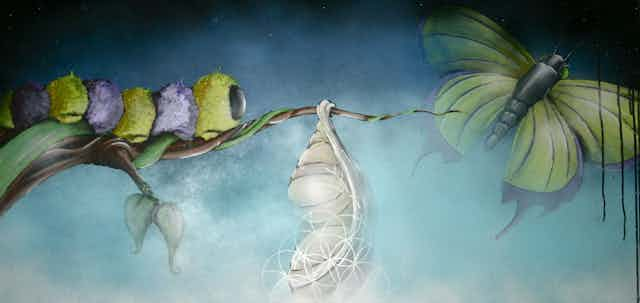The striking transformation of a caterpillar into a colourful, winged butterfly is one that has captivated scientists for years. The metamorphosis involves the breakdown of most of the caterpillar’s tissues before reassembling to form a butterfly. It therefore seems unlikely that butterflies or moths would remember experiences from their caterpillar days. However, scientists have now established that not only can a moth retain memories formed while it was a caterpillar, but that experiences gained during these early stages can have drastic impacts on adult life.
Memories live long
Moths and butterflies undergo drastic changes throughout their life-cycle, not just in their outward appearance, but also in their diet and overall lifestyle. Metamorphosis occurs within the pupal case. During this period, the larval brain stimulates the release of enzymes which dissolve most of its tissues into their constituent proteins through a process called histolysis. Then a group of specialised cells called histoblasts proceed to reconstruct the broken-down caterpillar body into that of a butterfly or a moth.
A few years ago, Martha Weiss and her group at Georgetown University discovered that aversive memories formed in the tobacco hornworm caterpillar (Manduca sexta) persisted throughout metamorphosis and were retained in adult moths.
Weiss trained caterpillars to avoid the odour of ethyl acetate, a chemical commonly used in nail polish removers. Caterpillars and moths are usually indifferent to the smell of ethyl acetate, but by pairing exposure to the odour with mild electric shocks, the scientists successfully taught these caterpillars to avoid the odour.
When given a choice of air or ethyl acetate, 78% of the caterpillars carefully avoided the odour in favour of air. Then, when adult moths developed from the pupae of trained caterpillars a month later, they continued to show a strong aversion to the smell, with 77% of the moths choosing air over ethyl acetate. Notably, the majority of moths choosing air as adults had also made the same choice as caterpillars, suggesting that individual preferences survived metamorphosis.

This study has shed some light on the intricacies of metamorphosis. Scientists have now set aside the notion that a caterpillar is completely disintegrated into a blended soup while in its cocoon. Instead, they now agree that it is more likely that certain parts of the brain may remain intact during the transition. The retention of memory in adulthood could be due to the carryover of intact neural connections formed during larval stages.
If caterpillar memories can continue into adulthood, then what about all of the other experiences that the larva has had? A few recent investigations have attempted to answer this question by manipulating the feeding habits of caterpillars.
Caterpillar diets decide butterfly colours
Caterpillars are essentially “eating machines”, gathering and storing up vital nutrients so that their adult forms can develop strong wings, flight muscles and other functional structures. Thus changes in the quality or quantity of food consumed during the larval stage can directly affect the size or strength of the mature butterfly.
However, it seems caterpillar diets can control far more than just the size of the adult. They can also affect wing colours, which in turn can influence flight durations, mating patterns and warning signals.
Most studies elucidating these connections have been done on the monarch butterfly (Danaus plexippus) that has spectacular orange and black wings – the shade of which varies subtly between individuals. Scientists are still trying to uncover the exact reasons for these slight differences in wing colour, and aside from genetics, environmental factors like caterpillar experiences are at the top of their list.

In a study published in April 2014, butterfly expert Andy Davis at the University of Georgia showed that caterpillars deprived of food for just one day develop into monarch butterflies with stunted, pale, and more yellow wings, while those who are allowed free access to food retain darker orange colours and larger wings.
While these subtle variations in wing colour may not be visible to the naked eye, they can have biologically meaningful outcomes. In fact, Davis has previously found that monarch butterflies with darker orange wings fly longer distances than those with lighter hues, and that migratory monarchs have darker orange (almost red) wings relative to non-migratory butterflies, suggesting a potential link between wing colour and flight propensity.
He has also reported that male monarchs with deeper shades of orange mate significantly more often than those with paler wings. While we don’t know the underlying cause for this just yet, there are speculations that the colour of a butterfly’s wings may relate to its scent, which could likely influence its mating success.
Other studies bolster the idea that both diet quality, and dietary restrictions, can affect wing colour.
For instance, butterflies that are potentially toxic to predators usually have a warning signal, often in the form of brightly coloured spots, to ward off attacks that would ultimately harm both them and the predator. The lustrous blue and orange spots on the swallowtail butterfly (which are well-known warning signals) are also known to change in intensity with food deprivation, but the effect of this variation on the efficacy of the warning signal remains to be explored.

However, not all findings are suggestive of a link between diet and wing colour. In Davis’s most recent study, in which caterpillars were deprived of food for two days instead of one, the resultant butterflies did not lose colour in their wings – this unexpected outcome is something that requires further investigation.
The complexities of metamorphosis continue to befuddle scientists to date, but one thing is clear: when you think back to the radical changes that a caterpillar undergoes inside its cocoon, it seems incredible that their early experiences can have such profound effects on their adult life.

